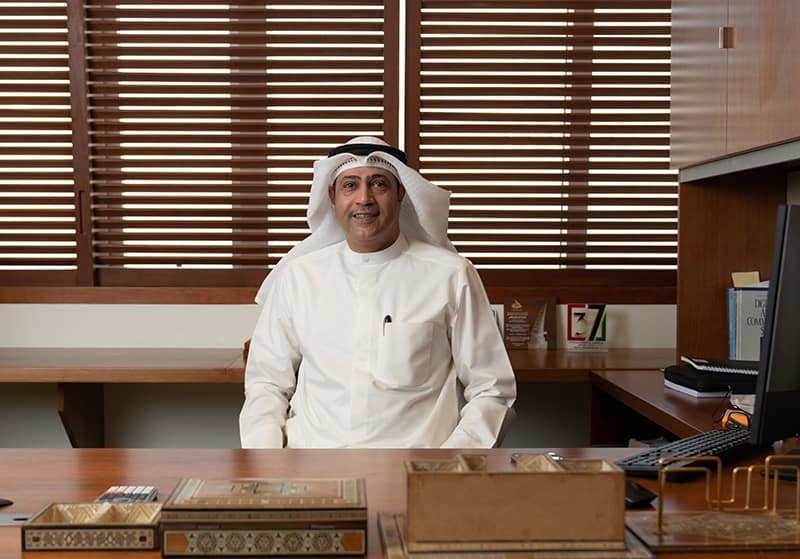A stroke is a deadly medical condition in which the blood supply to the brain cuts off due to a severe injury of a vascular cause - it is a medical emergency that needs treatment as soon as possible to avoid the maximum amount of damage to the patient.
قال المطيري: “السكتة الدماغية هي أحد أكثر أسباب الوفاة والعجز شيوعاً في العالم. يصاب نحو 16 مليون شخص سنوياً بالسكتات الدماغية، ويموت منهم ستة ملايين في حين يصاب ستةُ ملايين آخرون بعجز دائم. تفيد بيانات لمنظمة الصحة العالمية نُشرت في العام 2018 بأن الوفيات الناجمة عن السكتة الدماغية في الكويت بلغت 8.82 % من إجمالي الوفيات”.
In light of these statistics, Almutairi wanted to bring together a team to create an imaging machine that would detect these medical hazards in their initial stage, without exposing the patient to any harmful radiation. Almutairi received his bachelor’s in electrical engineering from the University of South Florida in early 1993. He was offered a full scholarship in the same year from Kuwait University for his graduate studies and ended up pursuing his master’s and Ph.D. in electrical engineering from the University of Florida, focusing mainly on wireless communication.
His career boasts many achievements, the most recent
being his services to his alma mater, Kuwait University, where he served as
the Vice Dean for Academic Affairs at
the College of Engineering and Petroleum, and then as the Dean for Admission and Registration until recently. He is a senior member of the Institute of Electrical and Electronics Engineers (IEEE) – an esteemed society for professionals – and has served
as an editor and reviewer for many
technical publications.
When faced with the jarring realities of strokes and the lacking medical equipment, Almutairi had the vision to create a portable microwave imaging system that would be relatively quick and cost-effective, as opposed to the traditional imaging scans that are common today. As microwave imaging is the core of this project, his team consists of qualified individuals that have been carefully selected based on their research experience and publications in the related field of microwave imaging. However, the road to realizing this project has not been easy.
قال المطيري: “كان لمؤسسة الكويت للتقدم العلمي دور رئيس في تحسين مقترح البحث من خلال عملية مراجعة صارمة”، مستذكرا التحديات الأولى التي واجهوها. كان الطريق لا يزال طويلاً أمام الفريق.
إن التصوير بالرنين المغناطيسي (MRI) والأشعة السينية والتصوير المقطعي المحوسب (CT) هي من بين الإجراءات الشائعة التي تُجرَى في إطار علاج السكتات الدماغية. لكن مع الأسف، فإنها قد تُعرِّض المرضى لمخاطر مختلفة فيما يواجهون بالفعل حالة طبية طارئة. قال المطيري: “إن العيوب الرئيسة للفحص بالأشعة المقطعية والتصوير بالأشعة السينية هي خطورة الإشعاعات نفسها”.
A brief list of hazards posed by these procedures includes ionizing radioactivity and cancer as potential risks, along with the high possibility of a false negative report. MRIs can detect the presence of a disease within the human body, but the procedure is more expensive than the others and is less effective in cases of strokes. Ultrasounds are another commonly used procedure, and while they work better for certain diseases, they are unable to produce a perfect image of the scanned area. For a medical emergency like a stroke, there must be a system in place that is quick, safe, and accurate.
قال المطيري: “هناك طلب كبير من أجل حل المشكلات المذكورة آنفاً من خلال تطوير تقنية مدمجة ومتحركة يمكن استخدامها على المريض في الوقت الفعلي، إما في غرفة النوم أو في غرفة الطوارئ لمتابعة السكتة الدماغية. ونظراً إلى السمات الجذابة للإشعاعات غير المؤينة ولكونها أقل تكلفة ولا تسبب آثاراً جانبية، يمكن استخدام تقنية التصوير المقترحة في كثير من الأحيان للتعرف على السكتة الدماغية في رأس الإنسان في أي وقت، مما يجعلها تتفوق على أنظمة التصوير المستخدمة حالياً”.
The imaging system works by employing prototyped wideband antennas that will be uniformly placed over the patient’s head. The signals transmitted by these antennas will have a higher detection sensitivity and will be collected by a commercially available microwave transceiver.
قـال المطيري: “تعتمد مراقبة السكتات الدماغية باستخدام نظام التصوير بالموجـات الصغرية علـى قياس الإشـارات المــيكروية التـي ينشرها رأس بشري مضــاء بالموجات الصغرية وتحليلها”.
One antenna at a time transmits the signals while the others receive them; these signals are then converted to digital data after which they are processed and analyzed to detect the pool of blood formed in the brain due to the stroke.
يخطط الفريق لإجراء عدة تجارب يضطلع خلالها، كما أوضح المطيري، “بمحاكاة عملية مراقبة السكتة الدماغية من بدايتها إلى الحالة المزمنة”. ستتابع عملية المراقبة هذه التجارب التي سيُستخدَم خلالها نظام التصوير عبر مراحل فسيولوجية مختلفة، وستُحدِّد نتيجتُها إمكانية النظر في إجراء تجارب إكلينيكية في سياقات واقعية. وحينما يُثبت النظام فاعليته في التجارب الإكلينيكية، سيكون عندئذٍ متاحاً للتطبيق في العيادات وسيارات الإسعاف لتوفير الرعاية والمتابعة للمرضى في مرحلة مبكرة.
As the project is still in its initial stages, there is still a long way to go until they can see results, however, Almutairi is optimistic about the progress and appreciates the funding KFAS
has provided.
قال المطيري: “ستؤدي نتيجة المشروع إلى تسريع الطلب المتزايد على أنظمة التصوير، لعلاج معدل الوفيات المرتفع بسبب السكتة الدماغية. وفي ذلك دعم لأهداف مؤسسة الكويت للتقدم العلمي في تحفيز تقدم العلوم والتكنولوجيا والابتكار، وتشجيعها لفائدة المجتمع الكويتي والأبحاث والمشاريع في الكويت”. يأمل المطيري أن يسهم نجاح هذا المشروع في مساعدة من لا يستطيعون تحمُّل تكاليف العلاجات باهظة الثمن، ومن ثم المساعدة على تقليل عدد الوفيات الناجمة عن السكتة الدماغية في الكويت مع تعزيز النمو الاقتصادي للبلاد، وهو يأمل أن يلهم هذا المشروع مزيداً من الأبحاث في هذا المجال، وأن يوسع حدود القدرات التقنية المحلية.
Innovating Imaging Systems for Stroke Detection
Ali Almutairi, a professor in the electrical engineering Department at Kuwait University, has put together a team to create a machine that will facilitate medical professionals in detecting strokes in a way that no one has done before.
